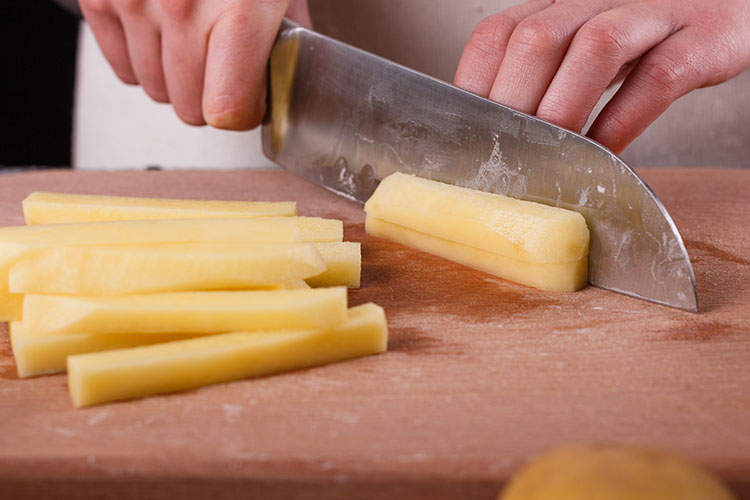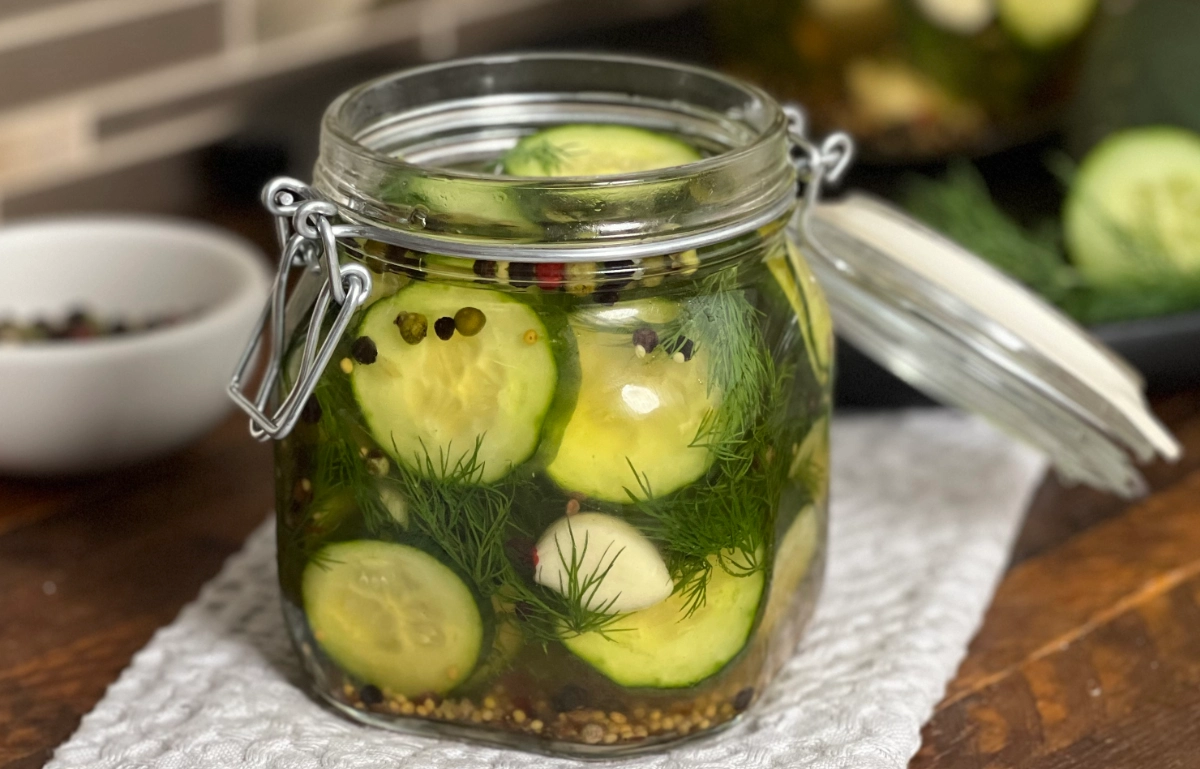Homemade Classic French Fries

Fries are kind of like pizza: even the bad ones are good to eat. There’s nothing quite like piping hot fries freshly salted, crunchy on the outside and still fluffy on the inside.
Everyone has gotten away from making their own fries with the advent of the easy-to-make, cost effective frozen varieties, but we’re here to change that. With our classic french fry recipe, you’ll have a hard time throwing the chemically-laden mass-produced versions in the oven.
With a little planning, you can have fresh, homemade classic french fries whenever you want. Let’s dig into the recipe.
Why are they called French fries?
Contrary to popular belief, the origins of french fries stem from Belgium, not France. In the book “Fries,” author Blake Lingle puts it lightly:
“That sliced potatoes were being fried alongside fish in the Meuse Valley in the late 1600’s, predating the French assertion by three quarters to a full century.”
So why do we call them French fries if they truly are of Belgian in nature? Let’s go to Lingle again for a possible explanation:
“We dumb Americans mistakenly gave french fries their ubiquitous title, confusing French-speaking Belgian soldiers holding delicious fried esculents with French-speaking French soldiers during the First World War.”
Sadly for the Belgians, assertion and popularity do not automatically substantiate origin as the first contemporary recipe for sliced and then fried potatoes can be found in a 1755 cookbook titled “Les soupers de la cour.”
Call them what you want, but I prefer using french as a verb: to cut into long thin strips.
Best potatoes for french fries
Let’s look at some popular potato options for making french fries.
Russet potatoes

Most potato fries in the United States come from the russet Burbank variety, and for good reason. Russets are a great option for frying as they have low sugar and moisture content paired with higher starch and deeper potato flavor than other varieties.
When russets are turned into fries correctly, they are light and fluffy on the inside and crispy on the outside. McDonald’s is a good example of this as they use russet potatoes for their fries.
White potatoes

White potato varieties are next in line. Compared to a russet, they have lower starch and whiter skin. Inside, they are creamier than russets making them faster to cook through. In-N-Out uses a variety of white potato for their fries called Kennebec white potatoes.
Yukon Gold potatoes

Yukon Gold potatoes are fairly new to the family tree. They’ve been around for a few decades through breeding techniques while whites and russets have been around longer than a century.
Yukon Gold fries are delicious. They have a deep flavor like a russet with the soft texture of a white. They stay extra crispy on the outside while maintaining a soft, buttery interior. If you’re having a hard time choosing which potato to start frying, choose a Yukon Gold potato.
Sweet potatoes

Sweet potatoes are another popular option floating around. Even though these root vegetables are starchy like regular potatoes, their increased sugar content makes them difficult to crisp up on the outside.
Mass producers circumvent this issue by adding a batter or coating externally. Otherwise, sweet potato fries become soggy almost immediately after leaving the fryer. A quick toss in flour, sugar or cornstarch will act as a barrier and crisp-aid to the outside.
Other vegetables
You can french and fry any vegetable you like, but the starchier options will hold up better on the outside and not collapse on themselves, becoming soggy messes out of the oil.
Tubers and root vegetables hold up well to the high heat of frying without becoming soggy. Tubers such as yuccas and turnips can be prepared the same way as potato fries.
Less starchy vegetables need a little help in the form of coatings or batter. Examples of this are onions rings and broccoli tempura. The coatings keep the outside crunchy and allow the middle flesh to cook through.
What is the best oil for french fries?
The type of fat you use will affect the final taste and texture of your fries. You will need an oil or fat with a high smoke point, usually above 360°F.
An oil or fat with a low smoke point will turn your food acrid as it breaks down, and increases the risk of grease fires.
Let’s look at some popular frying fats to consider:
Vegetable fats:
- Peanut oil
- Canola oil
- Sunflower
Animal fats:
- Beef tallow
- Lard
- Duck fat
These fat options are deep-fry friendly and sturdy enough to handle the rigorous heat of frying. Vegetable oils are higher in unsaturated fats, but also lower in flavor, while animal fats are higher in saturated fats and flavor.
I prefer deep frying in animal fats over vegetable oils whenever possible for the increased flavor and longevity of cripsiness. Leftover trimmings from brisket or rendered fats from pulled pork are great ways to source your own animal fats.
Coating options
Coatings can enhance both the crispiness and flavor of potato fries, but can quickly steal the show. Flour, cornstarch, and sugar are the main players in the coatings game giving golden-brown exteriors to their potato vehicles.
Seasonings can also be mixed into coatings, but again the more you add to the exterior batter, the less of the potato shines through. Mass produced french fries have a long ingredient list making one question viable: are you eating more potato or more batter?
If I’m going to coat my fires, a little bit of cornstarch for crispiness is all I need.
Sauces, seasonings, and toppings
A fry is best measured in its unaltered state with simple kosher salt sprinkled over top, but fries themselves have become an entree.
There’s no shortage of possibilities when it comes to fry accoutrements, so this is really up to personal preference. Ketchup, fry sauce, mayonnaise – these are all commonly served along naked fries. Malt vinegar and ranch are in the mix as well.

A simple toss in a dry seasoning out of the fryer will net you some delicious seasoned fries. Try one of our dry rub recipes for an easy flavor increase.
Feel free to experiment with sauces too – even our own BBQ sauce recipes or Blue Cheese Sauce for the more adventurous out there.

As for entrees, the same sentiment applies: Loaded fries, french fry nachos, and poutine are just a few examples of appetizer-turned-entree options.
The recipe: Classic Potato French Fries
Making your own french fries is both healthier and tastes better than buying the grocery store options. This recipe calls for parcooking and double-frying, so it takes a little planning ahead. Let’s dig in.
1. Prepare your potatoes
This recipe is for one serving per potato, so feel free to increase as needed.
Cut a medium sized, skin on Yukon Gold potato into quarter-inch strips (or russet, or white potato if you can’t find Yukon Gold).
There are a couple ways to cut the potatoes. If you have a mandolin slicer, there’s an attachment with cross-cutting teeth that makes perfectly consistent fries for frying. Mandolin slicers also have attachments for waffle fry cuts and shoestring fry cuts.
If you’re just using a knife, cut the potato in half lengthwise, then lay the cut side down and slice lengthwise into quarter-inch slices. Stack the slices and cut again for fries.

Soak the potato strips in water with a dash of apple cider vinegar. Soaking the potatoes draws starch to the exterior of the potato. This prevents fries from sticking together and helps them get crispy.
Vinegar delays potatoes from turning brown and also speeds up the starch extraction.
Soak the potatoes for at least an hour, but preferably overnight.
2. First fry: blanching
Frying at home can be a bit burdensome, but the right tools make it easy.
A thick bottomed or cast iron dutch oven makes for a perfect fryer with its high sides and temperature regulating thickness.

A thermometer is a must have. Instant read thermometers work well in a pinch, but a designated deep fry thermometer that clips onto the side of the pan will allow you to keep an eye on the oil temp throughout cooking.
Speaking of oil, I prefer beef tallow whenever possible for flavor and crispiness.
3. Cool the potatoes
Cooling the potatoes after the first fry is technically part of the blanching process.
Blanching the potatoes not only keeps them from browning after they’ve been cut, but also reduces momisture content which helps them crisp up more easily during the final fry.
Cooling or freezing the potatoes will add both taste and texture to your french fries, allowing for extra crispiness and golden exterior to your final product.
4. Second fry: final cook
The final cook is all about getting that crunchy, golden brown outside and soft, pillowy inside. Blanching the potatoes removes both omisture and starch so this last fry is all about the perfect taste and textures and only takes 1 – 2 minutes.
5. Season and serve

Be sure to drain and dry your fries out of the oil right away, easily done on a wire rack over a lined cookie sheet.
Season and serve the fries while hot.
Fry-yay
There you have it! Our easy-ish fry recipe. Much like BBQ, if you plan ahead you’ll have great fries at your disposal without the chemicals or artificial flavors that come with the mass produced kinds.
Of course these fries are great on their own with a pinch of salt, but here are some delicious options we like to make.

Use these french fries hot out of the fryer as a base and load them up. Similar to nachos, you can top with your favorite protein, veggies and cheeses. Some of my favorite ways to load fries are:
- Brisket and jalapeno loaded fries
- Chili cheese and bacon fries
- Korean bulgogi steak and kimchi fries

These fries also make a delicious addition to our grilled brisket breakfast burrito.
For a simpler take that’s no less tasty, toss the fries in a light coating of garlic butter and shred some fresh pecorino romano over top. Garnish with some chopped parsley and enjoy.
Try these other potato dishes
- Garlic and Rosemary Smoked Potatoes
- Herby Roasted Potato Salad
- Ultra Crispy Triple Cooked Potato Wedges

Homemade Classic French Fries
Ingredients
- 2 lbs medium Yukon Gold potatoes or russet
- Water for soaking
- Apple cider vinegar for soaking
- Kosher salt to taste
- Fat or oil for deep frying, enough to submerge the fries
Instructions
- Cut each unpeeled potato into quarter-inch strips.
- Soak the potato strips in water with a dash of apple cider vinegar for at least an hour, but preferably overnight.
- Drain the soaked potatoes and dry them on a cookie sheet lined with paper towels.
- While the potatoes are drying, prepare your frying fat to 300°F. I prefer beef tallow whenever possible for flavor and crispiness.
- Add the dried potatoes to the hot oil and deep fry for five minutes in the oil.
- Cool or freeze the blanched potato cuts. I prefer freezing them until they are frozen as you can do it in bulk and pull what you need when you need it, but you can also cool to room temperature spread out on a tray, or in the fridge until they’re cold.
- Heat the fat to 360°F. Toss in the cooled or frozen potato cuts and fry for 1 -2 minutes.
- Remove the cooked fries to a wire rack over a lined cookie sheet to drain and dry for a minute.
- Immediately salt and serve while hot with your preferred sauce.









